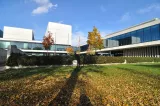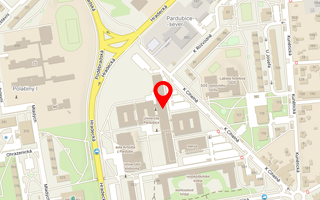The city of Pardubice, located in eastern Bohemia, has long been a regional centre, flourishing under the rule of the Pernštejn family. Today, it serves as the capital of the Pardubice Region and is known for its beautiful historical centre, architectural monuments, rich gingerbread-making tradition, and the famous Velká pardubická steeplechase.
Don’t miss the chance to visit some of the city’s most interesting landmarks:
Pardubice Castle, located in the heart of Pardubice, is a prominent Renaissance monument originally built in the 13th century as a Gothic fortress and later transformed into a Renaissance residence by the noble Pernštejn family. The castle’s distinctive white façade and arcaded courtyard (přihrádek) are central to the city’s historic core. Nearby, Pernštejnské náměstí serves as a vibrant square surrounded by charming burgher houses and cafés, reflecting Pardubice’s rich history and lively urban atmosphere. Together, these sites form a cultural and architectural centrepiece that showcases the city’s medieval and Renaissance heritage.
Automatické mlýny (Winternitz Automatic Mills) is a monumental industrial building designed by Josef Gočár, a leading figure of Czech modernism. Its striking brick façades and functionalist forms make it a landmark of early 20th‑century industrial architecture, now housing the East Bohemian Gallery alongside other cultural spaces.
Machoňova pasáž (Machoň Arcade) is a covered shopping arcade designed by Ladislav Machoň in the Art Deco tradition. It connects the bustling Třída Míru with the Karlovina district and is part of a five‑story mixed‑use building featuring shops beneath a glass‑vaulted ceiling.
Kostel svatého Bartoloměje (St. Bartholomew’s Church) in the heart of Pardubice is a Late Gothic Roman Catholic landmark. It is renowned for its uncommon Renaissance-style portal and historically served as a burial site for the influential Pernštejn family.
Památník Zámeček (Zámeček Memorial), located on the outskirts of Pardubice, marks the site of a former Nazi execution ground where 194 people were killed following the 1942 assassination of Reinhard Heydrich, the Deputy Reich-Protector of Bohemia and Moravia. It features a granite monument and a modern underground museum with multimedia exhibits and survivor testimonies, honoring the victims of wartime terror.
Pardubické krematorium (Pardubice Crematorium), designed by Pavel Janák, is a notable example of Rondocubist architecture, combining national decorative motifs with modernist forms. It is also known as a key filming location for Juraj Herz’s 1968 surreal, psychological horror The Cremator.
Here are some tips for visiting other nearby places:
Kunětická Hora
Located just about 6 km from Pardubice, Kunětická Hora Castle stands atop a solitary hill, offering sweeping views of the surrounding countryside. The castle is surrounded by charming walking trails and a peaceful natural setting, including a small wildlife preserve, making it an ideal spot for a relaxing trip into nature near the city.
Hradec Králové
Located about 25 km north of Pardubice, Hradec Králové is a vibrant city known for its elegant architecture and lively cultural scene. Its charming historic centre features a mix of Gothic, Renaissance, and Baroque buildings, while the modernist urban planning by Jan Kotěra and Josef Gočár gives the city its distinctive character. With its spacious squares, riverside promenades, and numerous cafés and galleries, Hradec Králové is a pleasant destination for a day trip full of history and atmosphere.
Kladruby nad Labem (UNESCO)
Located about 30 km from Pardubice, Kladruby nad Labem is renowned for its National Stud Farm, a UNESCO World Heritage Site dedicated to preserving the famous Kladruber horse breed. The stud dates back to the 16th century and is one of the oldest in Europe, known for breeding elegant, powerful horses traditionally used in ceremonial and royal events. Visitors can explore the historic stables, admire the beautiful Baroque architecture, and learn about the unique heritage of horse breeding in the region.
Seč and Železné hory
Located about 40 km south of Pardubice, Seč Reservoir is a popular recreational area nestled in the scenic Železné hory (Iron Mountains). The reservoir offers opportunities for swimming, boating, and relaxing on its beaches, while the surrounding hills are crisscrossed with hiking and cycling trails. The combination of water and forested landscapes makes it a perfect destination for outdoor activities and enjoying the natural beauty of the region.
Zámek Žleby
Located about 50 km from Pardubice, Žleby Chateau is a romantic castle with roots dating back to 1289. Originally a Gothic fortress linked to Emperor Charles IV, it was rebuilt in late Gothic and Renaissance styles before receiving its current picturesque English Gothic Revival appearance during a 19th-century Romantic renovation by the Auersperg family. The chateau’s distinctive ramparts, towers, and elegant interiors – including collections of weapons, stained glass, and period furnishings – reflect its rich noble heritage. Surrounded by a park and a nearby game preserve, Žleby offers visitors a charming glimpse into centuries of Bohemian history and aristocratic life.
Pilgrimage Church of St John of Nepomuk at Zelená Hora (UNESCO)
Located about 70 km from Pardubice, the Pilgrimage Church of St. John of Nepomuk at Zelená Hora in Žďár nad Sázavou is a remarkable UNESCO World Heritage Site. Designed by the visionary architect Jan Blažej Santini‑Aichel, the church is an extraordinary example of Baroque Gothic style, with its unique star‑shaped ground plan and symbolic design elements. Surrounded by peaceful hills and meadows, it offers visitors both architectural wonder and a serene atmosphere.
Kutná Hora (UNESCO)
Located about 70 km from Pardubice, Kutná Hora is a charming historic town and UNESCO World Heritage Site famous for its remarkable landmarks. Highlights include the majestic Gothic Cathedral of St. Barbara, with its intricate vaulting and frescoes, and the eerie yet fascinating Sedlec Ossuary, a chapel adorned with thousands of human bones. Both offer unforgettable glimpses into the region’s rich history and unique atmosphere.
Praha (UNESCO)
Located about 100 km from Pardubice, Prague is the Czech Republic’s capital and a UNESCO World Heritage Site celebrated for its stunning architecture and rich history. Key landmarks include the majestic Prague Castle, the historic Charles Bridge, and the picturesque Old Town Square with its famous Astronomical Clock. The city’s blend of Gothic, Baroque, and Renaissance architecture, alongside vibrant cultural life, makes it a must-visit destination.





